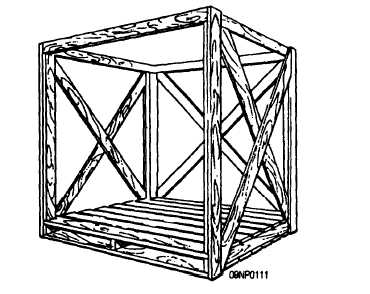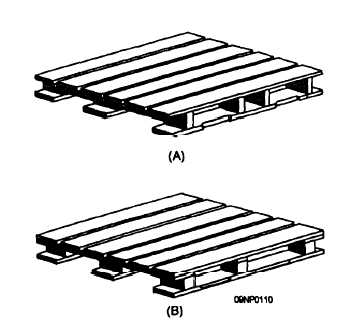| |
chain may be used depending on the weight of material
to be lifted.
Slings have rigid horizontal supports at the base.
Usually made of steel bars or pipes that must be of
sufficient strength to distribute the load across the entire
length.
Some slings have movable spreader bars at the top
to prevent the load from being crushed when lifted.
PALLETS
A pallet is a wooden, steel, or aluminum platform
on which supplies are loaded, transported, or stored in
units. Use of pallets permits handling the material with
forklift trucks, cranes, and other transporting
equipment.
The standard pallet is a 40- by 48-inch platform that
accommodates most packages and stores in
warehouses. It is regarded as the general-purpose
pallet. General-purpose pallets maybe either the flat
type or box type. Flat Pallets may be single-faced or
double-faced. Single-faced pallets (figure 13-11) have
one platform nailed or bolted to stringers, usually made
of 2- by 4-inch material. A double-faced pallet (figure
13-10) has platforms on the top and the bottom of the
stringers and is excellent for stevedoring and
transit-shed operations.
The box-type pallet, illustrated in figure 13-12, is
used for handling small-lot items or easily crushed
Figure 13-12.—Box pallet.
cargo. When discharging items from a ship to a transit
shed, loading directly into a box pallet saves
considerable time and labor.
Nestable sheet metal pallets are convenient for three
reasons (1) the maintenance cost is low, (2) they save
storage space, and (3) you have no problem keeping
them sanitary. Figure 13-13 shows a few single-faced
pallets stowed alongside a stack of sheet-metal pallets.
As you can see, the saving in storage space is
tremendous.
Lightweight aluminum pallets also are used, but are
expensive and difficult to repair.
In addition to the standard pallet there is a 48- by
72-inch stevedoring pallet, which is used primarily for
transporting and storing drummed products and for
stevedoring purposes.
Pallet construction and
illustrations on the stevedore pallet can be found in
NAVSUP P-284-1.
Loading Pallets
When a pallet is loaded, three things must be
Figure 13-11.—Pallet, x 48-inches, four-way entry:
Partial stringers (B) Post canstruction.
(A)
considered: (1) maximum load, (2) stability, and (3)
proper pallet size. The pallet must pass through all
doors, aisles, and hatches likely to be encountered. The
stability of the material on the pallet must be considered
and a decision made as to the type of pallet to use.
Figure 13-14 shows the recommended way to load
material on a pallet. The size of the boxes being loaded
will determine their arrangement on the pallet. A
standard loading pattern is not always appropriate.
13-5
|


